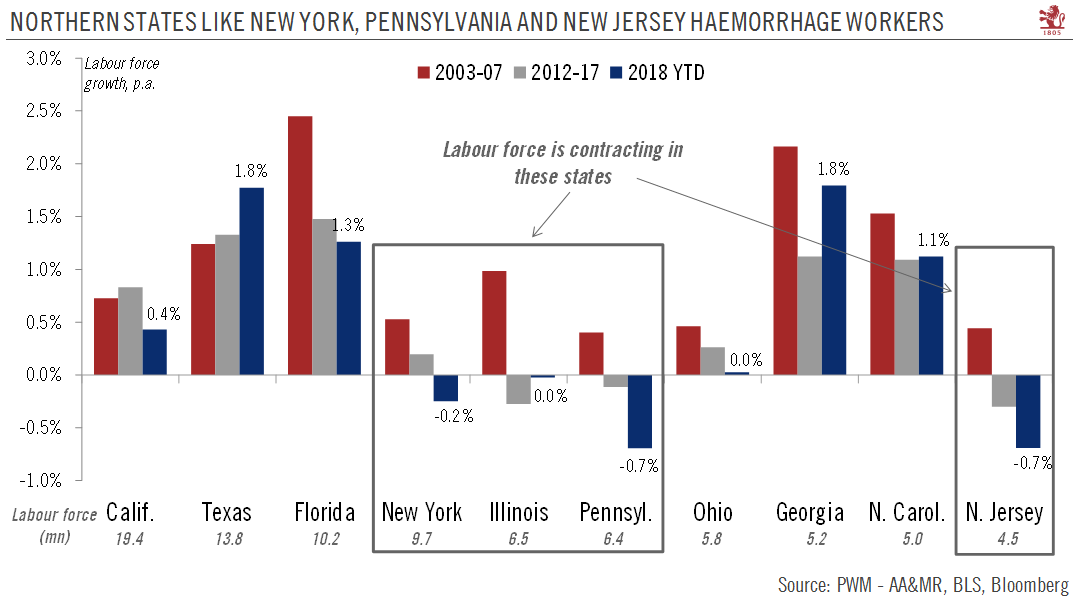Internal migration patterns could have far-reaching political consequences in coming elections.One salient feature of the US since its foundation has been the dynamism of internal migration. In recent decades, the trend has mostly been one of southern and western tropism, with an outflow of population from the north (the northeast in particular), to the south and west of the country.This trend seems to have amplified since the 2008 financial crisis. And data for this year suggests a further acceleration in internal migration. This is worrying for northern states, as corporations see an erosion of the labour pool and state finances suffer from the loss of potential taxpayers. The sharpest absolute growth in workforce so far this year (January-September), has been seen in Texas (+240,000
Topics:
Thomas Costerg considers the following as important: Macroview, US demographics, US elections, US politics
This could be interesting, too:
Cesar Perez Ruiz writes Weekly View – Big Splits
Cesar Perez Ruiz writes Weekly View – Central Bank Halloween
Cesar Perez Ruiz writes Weekly View – Widening bottlenecks
Cesar Perez Ruiz writes Weekly View – Debt ceiling deadline postponed
Internal migration patterns could have far-reaching political consequences in coming elections.
One salient feature of the US since its foundation has been the dynamism of internal migration. In recent decades, the trend has mostly been one of southern and western tropism, with an outflow of population from the north (the northeast in particular), to the south and west of the country.
This trend seems to have amplified since the 2008 financial crisis. And data for this year suggests a further acceleration in internal migration. This is worrying for northern states, as corporations see an erosion of the labour pool and state finances suffer from the loss of potential taxpayers. The sharpest absolute growth in workforce so far this year (January-September), has been seen in Texas (+240,000 people versus the same period last year).
This dwarfs Florida’s 127,000 gain, Georgia’s 91,000 and California’s 83,000, illustrating the ongoing economic boom in Texas thanks to its shale oil resources (the US as a whole is now producing roughly 11 million barrels per day, compared with 5 million 10 years ago).
Interestingly, California, once buoyant, seems to be losing momentum this year. Its labour force is on track to grow only 0.4% in 2018, down from 0.8% on average in 2012-17. Unless there is less than meets the eye in the flourishing tech scene, it is hard to understand what is behind this relative slowdown. Many potential new migrants may have been discouraged by the flip side of the ongoing boom, especially the sharp rise in cost of living, including housing.
Still, California looks unlikely to lose its crown as US state with the biggest workforce; even if the 2018 trend continues, Texas’ workforce will not overtake California’s until 2044.
The trends in internal migration could have political ramifications, since the states losing workers like New York, New Jersey and Illinois are mostly Democrat bastions (even though north-eastern states like Pennsylvania and Ohio shifted away from the Democrats towards Trump in the 2016 presidential elections).
Florida is a place to watch in this regard, as it is a notorious swing state in US politics and could once again play a key role in the November 2018 midterm elections. In 2016, Trump won the state, 49.0% versus Hillary Clinton’s 47.8%. But Florida has gained 127,000 more people of working age this year, after 251,000 last year and 216,000 in 2016. Florida’s population is also growing rapidly because of the continued strong inflow of retirees, including from the Northeast.
The inflow of voters from traditionally Democrat-leaning states into Florida and elsewhere in the South is only one element of the equation going into the 6 November midterms and should not be exaggerated. The key challenge remains whether both parties manage to get their supporters to actually cast their votes; US midterm elections traditionally have low turnout rates.
That said, should the inflow of Northern workers continue, there could be a structural rise in Democrats’ electoral base in some southern states like Florida, potentially tipping the odds in coming elections. Texas, long considered a Republican stronghold, could start to see more Democrat encroachment going forward.

